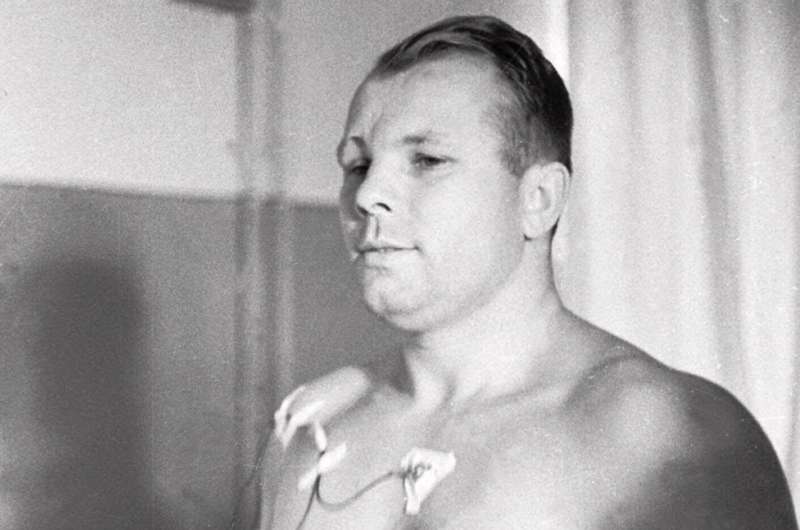Crushed into the pilot's seat by heavy G-forces, Soviet cosmonaut Yuri Gagarin saw flames outside his spacecraft and prepared to die. His voice broke the tense silence at ground control: "I'm burning. Goodbye, comrades."
Gagarin didn't know that the blazing inferno he observed through a porthole was a cloud of plasma engulfing Vostok 1 during its re-entry into the Earth's atmosphere, and he was still on track to return safely.
It was his quiet composure under pressure that helped make him the first human in space 60 years ago.
Gagarin's steely self-control was a key factor behind the success of his pioneering 108-minute flight. The April 12, 1961, mission encountered glitches and emergencies—from a capsule hatch failing to shut properly just before blastoff to parachute problems in the final moments before touchdown.
From the time 20 Soviet air force pilots were selected to train for the first crewed spaceflight, Gagarin's calm demeanor, quick learning skills and beaming smile made him an early favorite.
Two days before blastoff, the 27-year-old Gagarin wrote a farewell letter to his wife, Valentina, sharing his pride in being chosen to ride in Vostok 1 but also trying to console her in the event of his death.
"I fully trust the equipment, it mustn't let me down. But if something happens, I ask you Valyusha not to become broken by grief," he wrote, using a nickname for her.

Authorities held onto the letter and eventually gave it to Gagarin's widow seven years later after he died in an airplane crash. She never remarried.
Gagarin's pioneering, single-orbit flight made him a hero in the Soviet Union and an international celebrity. After putting the world's first satellite into orbit with the successful launch of Sputnik in October 1957, the Soviet space program, rushed to secure its dominance over the United States by putting a man into space.
"The task was set, and people were sleeping in their offices and factory shops, like at wartime," Fyodor Yurchikhin, a Russian cosmonaut who eventually made five spaceflights, recalled.
As the Soviet rocket and space program raced to beat the Americans, it suffered a series of launch failures throughout 1960, including a disastrous launch pad explosion in October that killed 126 people. Missile Forces chief Marshal Mitrofan Nedelin was among the victims.
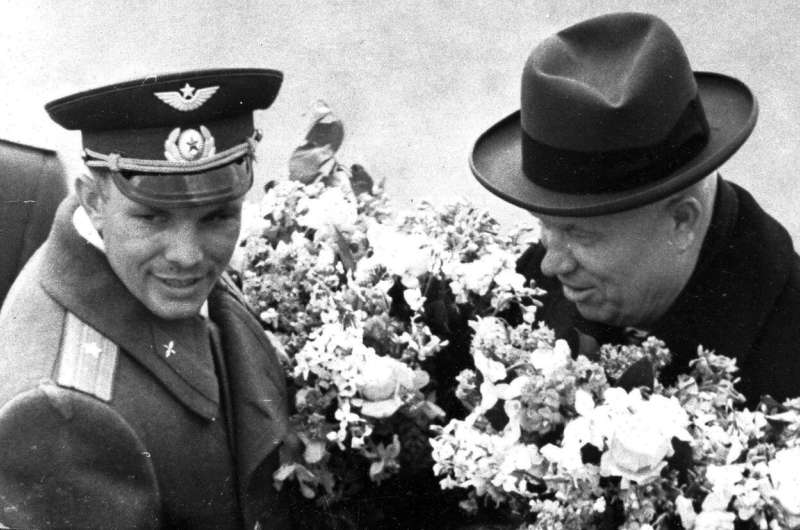
Like Gagarin, Soviet officials were prepared for the worst. No safety system had been installed to save the cosmonaut in case of another rocket explosion at blastoff or after.
Authorities drafted three versions of a bulletin about Gagarin's flight for the official TASS news agency: one announcing a successful flight, another in case of problems, and the third one for a mission ending in disaster.
Apart from potential engine failures and other equipment malfunctions, scientists questioned an individual's ability to withstand the conditions of spaceflight. Many worried that a pilot could go mad in orbit.
Soviet engineers prepared for that situation by developing a fully automatic control system. As an extra precaution, the pilot would receive a sealed envelope containing a secret code for activating the capsule's manual controls. The theory was that a person who could enter the code must be sane enough to operate the ship.
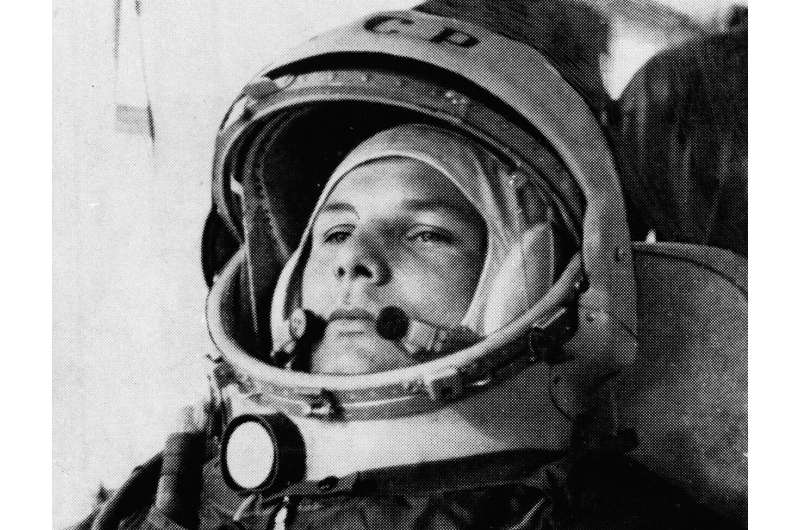
Everyone in the space program liked Gagarin so much, however, that a senior instructor and a top engineer independently shared the secret code with him before the flight to save him the trouble of fiddling with the envelope in case of an emergency.
Problems began right after Gagarin got into Vostok 1, when a light confirming the hatch's closure did not go on. Working at a frantic pace, a leading engineer and a co-worker removed 32 screws, found and fixed a faulty contact, and put the screws back just in time for the scheduled launch.
Sitting in the capsule, Gagarin whistled a tune. "Poyekhali!"—"Off we go!"—he shouted as the rocket blasted off.
As another precaution, the orbit was planned so the spacecraft would descend on its own after a week if an engine burn failure stranded the ship. Instead, a glitch resulted in a higher orbit that would have left Gagarin dead if the engine had malfunctioned at that stage.

While the engine worked as planned to send the ship home, a fuel loss resulted in an unexpected reentry path and a higher velocity that made the ship rotate wildly for 10 agonizing minutes.
Gagarin later said he nearly blacked out while experiencing G-forces exceeding 10 times the pull of gravity. "There was a moment lasting two or three seconds when instruments started fading before my eyes," he recalled.
Seeing a cloud of fiery plasma around his ship on re-entry, he thought his ship was burning.
A soft-landing system hadn't been designed yet, so Gagarin ejected from the module in his spacesuit and deployed a parachute. While descending, he had to fiddle with a sticky valve on his spacesuit to start breathing outside air. A reserve chute unfolded in addition to the main parachute, making it hard for him to control his descent, but he landed safely on a field near the Volga River in the Saratov region.
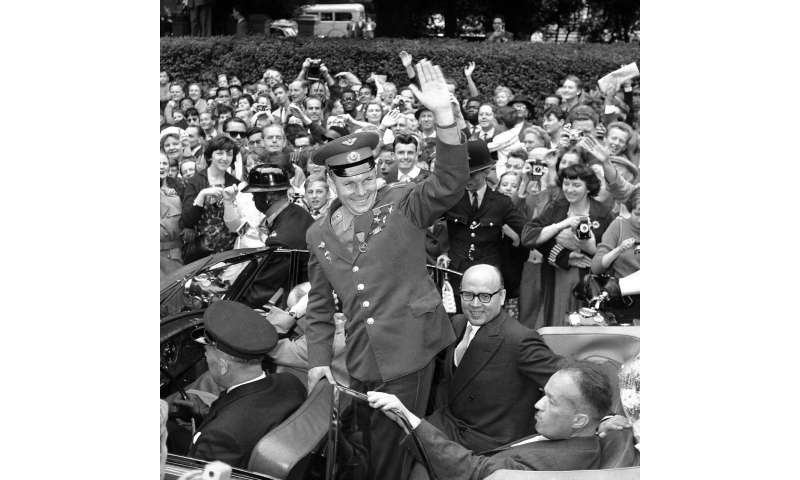
In this July 15, 1961 file photo, Major Yuri Gagarin, the Russian astronaut, waves his greeting to spectators as he leaves the Soviet Embassy in London, United Kingdom, after his visit to Britain. He was mobbed by hundreds of onlookers and well-wishers as he drove from the embassy to London airport. The successful one-orbit flight on April 12, 1961 made the 27-year-old Gagarin a national hero and cemented Soviet supremacy in space until the United States put a man on the moon more than eight years later. (AP Photo/Dennis Lee Royle, File) 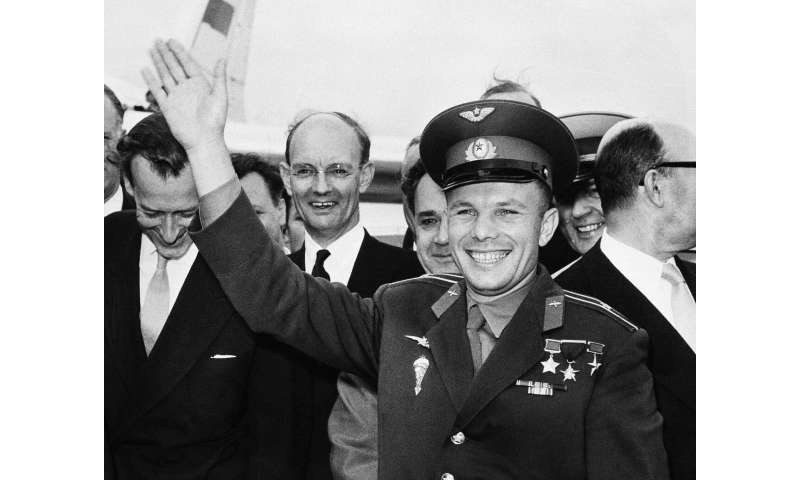
In this Tuesday, July 11, 1961 file photo, Soviet spaceman Yuri Gagarin waves after arriving at the London Airport, for a private visit as the guest of the Russian Trade fair. The successful one-orbit flight on April 12, 1961 made the 27-year-old Gagarin a national hero and cemented Soviet supremacy in space until the United States put a man on the moon more than eight years later. (AP Photo/File) 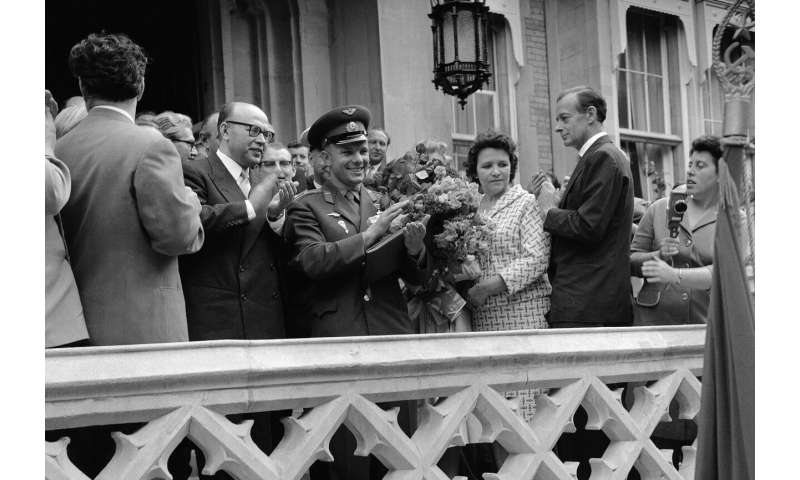
In this Tuesday, July 11, 1961 file photo, Russian cosmonaut Major Yuri Gagarin, center, with a large bouquet on his arm, applauds at the Russian embassy in London, after his arrival from London Airport.The successful one-orbit flight on April 12, 1961 made the 27-year-old Gagarin a national hero and cemented Soviet supremacy in space until the United States put a man on the moon more than eight years later. (AP Photo/File) 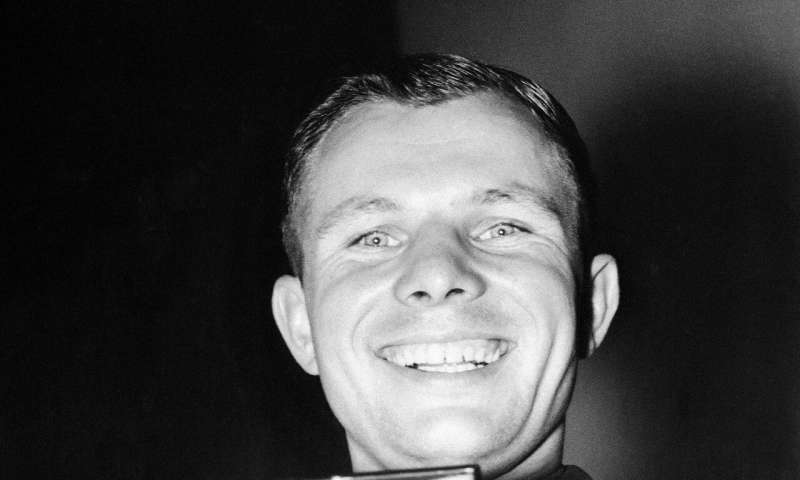
In this Tuesday, July 11, 1961 file photo, Major Yuri Gagarin, the Russian cosmonaut, holds the gold medal of the British Interplanetary Society after it was awarded to him after his press conference at the Soviet exhibition in Earls Court, London. The successful one-orbit flight on April 12, 1961 made the 27-year-old Gagarin a national hero and cemented Soviet supremacy in space until the United States put a man on the moon more than eight years later. (AP Photo/File) 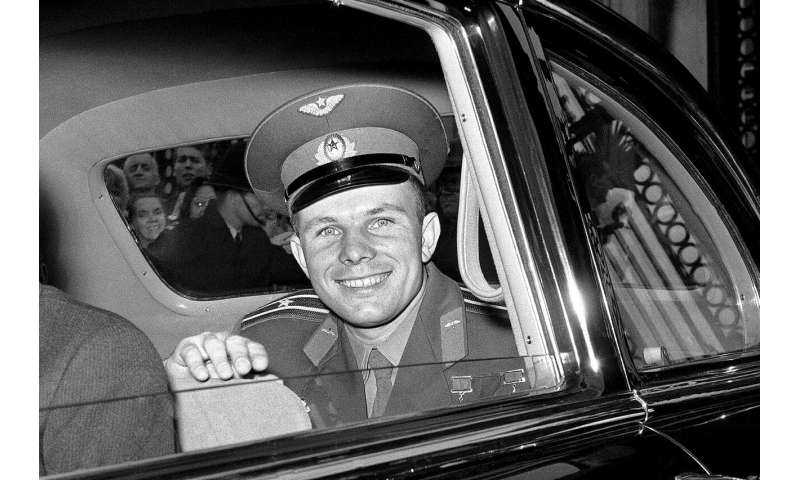
In this Friday, July 14, 1961 file photo, Major Yuri Gagarin, the Russian cosmonaut, smiles as he leaves Buckingham Palace in London, United Kingdom, after lunch with Queen Elizabeth II. He is visiting Britain in connection with the soviet exhibition in London. The successful one-orbit flight on April 12, 1961 made the 27-year-old Gagarin a national hero and cemented Soviet supremacy in space until the United States put a man on the moon more than eight years later. (AP Photo/Brian Calvert, File) 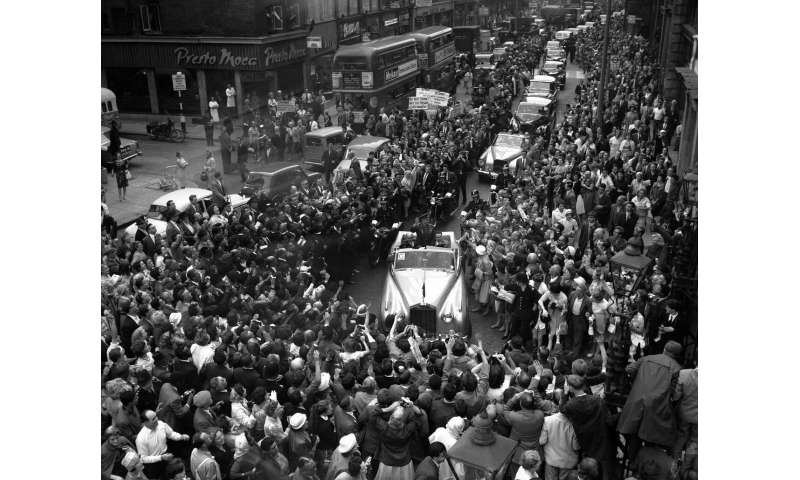
In this Tuesday, July 11, 1961 file photo, Russian cosmonaut Major Yuri Gagarin, standing in an open car, waves to crowds of spectators as he drives into London from the London airport. The successful one-orbit flight on April 12, 1961 made the 27-year-old Gagarin a national hero and cemented Soviet supremacy in space until the United States put a man on the moon more than eight years later. (AP Photo/File) 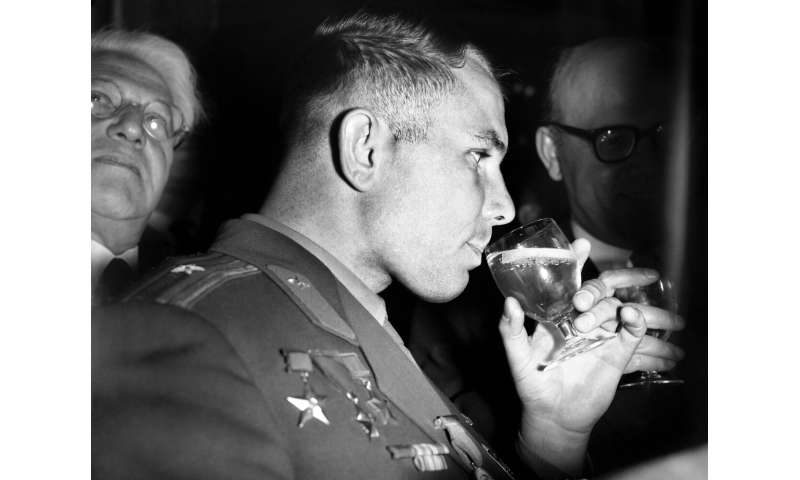
In this Thursday, July 13, 1961 file photo, Yuri Gagarin, the Soviet cosmonaut, sips a cool drink at a reception in his honor at Hyde Park Hotel, London. The successful one-orbit flight on April 12, 1961 made the 27-year-old Gagarin a national hero and cemented Soviet supremacy in space until the United States put a man on the moon more than eight years later. (AP Photo/Bob Dear, File) 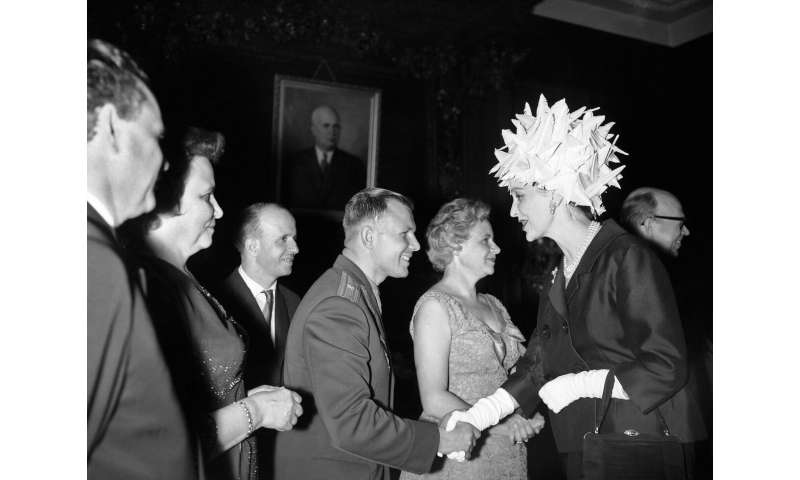
In this Tuesday, July 11, 1961 file photo, Mrs. John Profumo, formerly actress Valerie Hobson, now the wife of the Secretary of State for War, shakes hands with Major Yuri Gagarin, Russia's cosmonaut, at a reception given in Gagarin's honor at the Soviet Embassy in London. The successful one-orbit flight on April 12, 1961 made the 27-year-old Gagarin a national hero and cemented Soviet supremacy in space until the United States put a man on the moon more than eight years later. (AP Photo/Bob Dear, File) 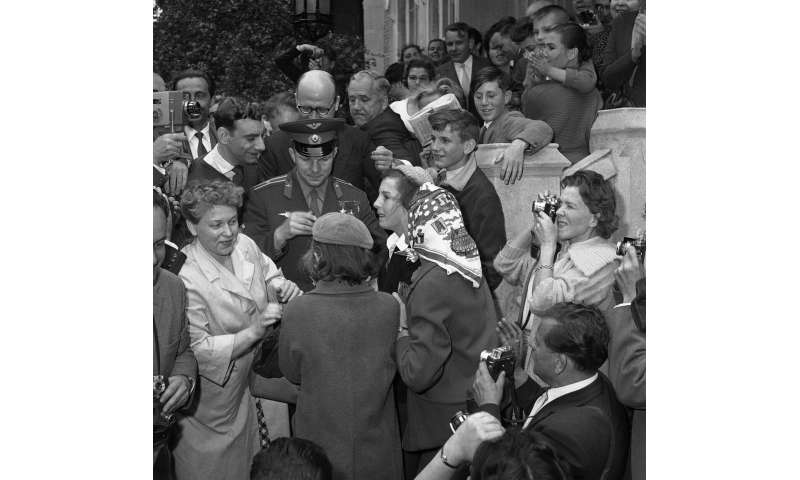
In this Saturday, July 15, 1961 file photo, autograph hunters jostle round Major Yuri Gagarin, the Russian cosmonaut, at the Soviet Embassy in London, as he left for London airport after his visit to Britain in connection with the soviet exhibition in London. The successful one-orbit flight on April 12, 1961 made the 27-year-old Gagarin a national hero and cemented Soviet supremacy in space until the United States put a man on the moon more than eight years later. (AP Photo/Dennis Lee Royle, File) 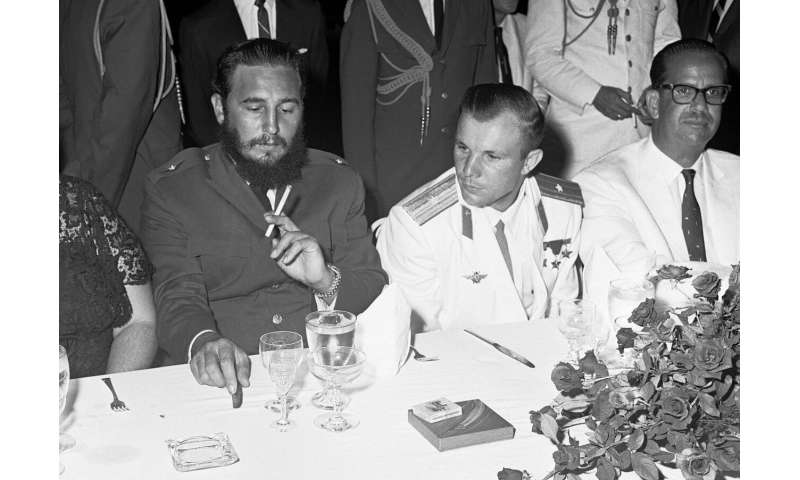
FILE In this Wednesday, July 26, 1961 file photo, Cuba's leader Fidel Castro, left, a regular cigar smoker, opens a box of Russian cigarettes while sitting beside Russia's spaceman Yuri Gagarin at a reception during the four-day celebration at the Russian Embassy in Havana. The successful one-orbit flight on April 12, 1961 made the 27-year-old Gagarin a national hero and cemented Soviet supremacy in space until the United States put a man on the moon more than eight years later. (AP Photo/File) 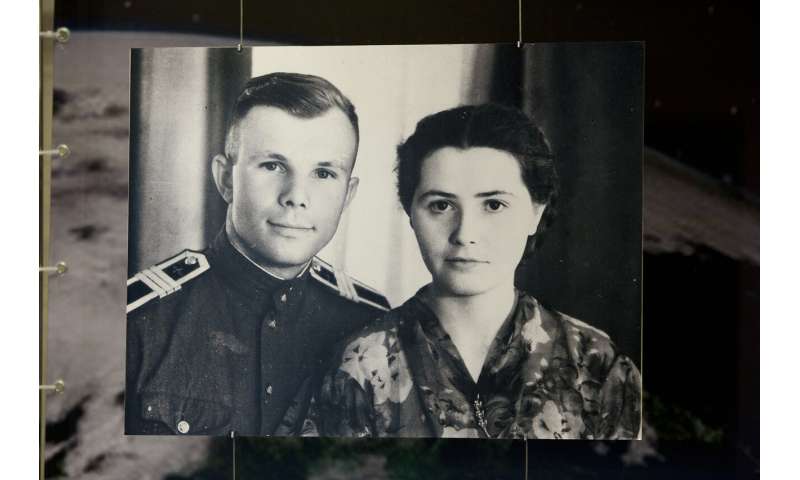
This Tuesday, April 5, 2011 file photo, shows an undated photo of the first man in space Yuri Gagarin and his wife Valentina on a display at the upper house of Russian parliament in Moscow, Russia. The successful one-orbit flight on April 12, 1961 made the 27-year-old Gagarin a national hero and cemented Soviet supremacy in space until the United States put a man on the moon more than eight years later. (AP Photo/Alexander Zemlianichenko, File) 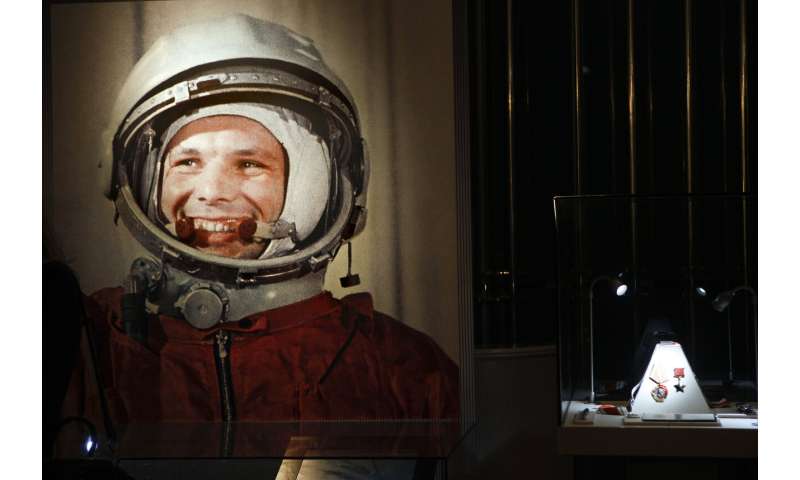
This Monday, April 11, 2011 file photo shows an undated portrait of the first man in space, Yuri Gagarin, and his award of the Hero of the Soviet Union, at right, as part of an exhibition dedicated to the 50th anniversary of the first man in space, in Moscow, Russia. The successful one-orbit flight on April 12, 1961 made the 27-year-old Gagarin a national hero and cemented Soviet supremacy in space until the United States put a man on the moon more than eight years later. (AP Photo/Alexander Zemlianichenko, File) 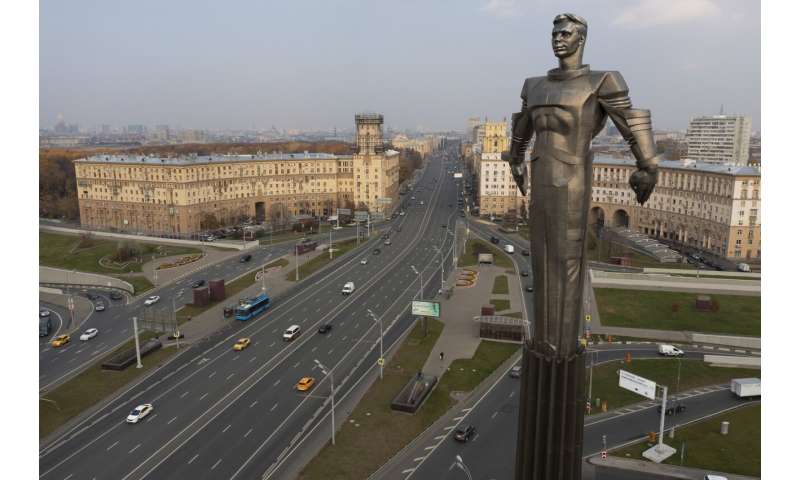
This Friday, Oct. 19, 2018 photo shows the 42-meter (138-feet) high and 12 ton (26,455 pounds) monument built in 1980 of Yuri Gagarin, the first person who flew to space, became a Moscow landmark. Gagarin's statue standing on a pedestal made to resemble a rocket exhaust is made of titanium. The successful one-orbit flight on April 12, 1961 made the 27-year-old Gagarin a national hero and cemented Soviet supremacy in space until the United States put a man on the moon more than eight years later. (AP Photo/Maxim Marmur) 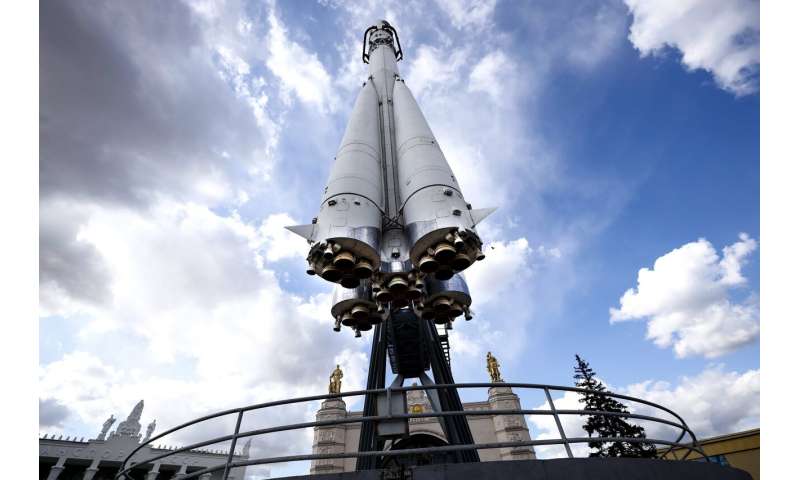
A Vostok rocket similar to the one that carried Yuri Gagarin on his flight to space is displayed in Moscow, Russia, Friday, April 9, 2021. Soviet cosmonaut Yuri Gagarin became the first human in space 60 years ago. The successful one-orbit flight on April 12, 1961 made the 27-year-old Gagarin a national hero and cemented Soviet supremacy in space until the United States put a man on the moon more than eight years later. (AP Photo/Alexander Zemlianichenko)
Gagarin was flown to Moscow to a hero's welcome, hailed by Soviet leader Nikita Khrushchev and greeted by enthusiastic crowds cheering his flight as a triumph on par with the victory in World War II. In the years before he died at age 34, he basked in international glory, visiting dozens of countries to celebrate his historic mission.
"The colossal propaganda effect of the Sputnik launch and particularly Gagarin's flight was very important," Moscow-based aviation and space expert Vadim Lukashevich said. "We suddenly beat America even though our country hadn't recovered yet from the massive damage and casualties" from World War II.
Gagarin was killed in a training jet crash on March 27, 1968. Not quite 16 months later, the U.S. beat the Soviet Union in the space race, putting an astronaut on the moon.
The 1991 collapse of the Soviet Union ended the era of rivalry. Russia's efforts to develop new rockets and spacecraft have faced endless delays, and the country has continued to rely on Soviet-era technology. Amid the stagnation, the much-criticized state space corporation Roscosmos has focused on a costly plan to build its new, rocket-shaped headquarters on the site of a dismantled rocket factory.
Explore further
© 2021 The Associated Press. All rights reserved. This material may not be published, broadcast, rewritten or redistributed without permission.



